Partners for life: CIMMYT and maize researchers in eastern Africa
CIMMYT E-News, vol 5 no. 1, January 2008
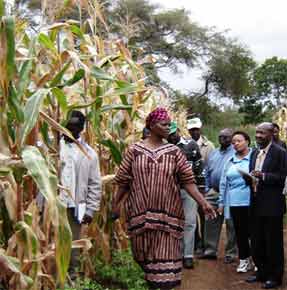 CIMMYT’s partnerships on maize in eastern Africa hark back to the 1960s, when the center was launched. Formal networking since that time with researchers and extension workers, policy makers, non-government organizations, seed companies, millers, and farmers have culminated in successful breeding and dissemination teams and promising new varieties rated highly by farmers. Awards to teams in Tanzania and Ethiopia recently highlighted the value of these partnerships.
CIMMYT’s partnerships on maize in eastern Africa hark back to the 1960s, when the center was launched. Formal networking since that time with researchers and extension workers, policy makers, non-government organizations, seed companies, millers, and farmers have culminated in successful breeding and dissemination teams and promising new varieties rated highly by farmers. Awards to teams in Tanzania and Ethiopia recently highlighted the value of these partnerships.
During a travel workshop, CIMMYT and national scientists observing maize breeding and dissemination activities in Ethiopia, Kenya, Tanzania, and Uganda jointly selected the recipients of the two awards, one for the best regional technology dissemination team, led by the Selian Agricultural Research Institute (SARI), Tanzania, and one for the best regional maize breeding team for drought tolerance: the Ethiopian Institute of Agricultural Research (EIAR)-Melkassa Research Centre.
“The awards recognize the products of long-term collaboration and team-building in the region, oriented towards the rapid development, release, and scaling-up of locally adapted, stress tolerant, and nutritionally enhanced maize varieties,” says Wilfred Mwangi, leader of the Drought Tolerant Maize for Africa (DTMA) project, which was launched in 2006 and which sponsored the awards. “We hope the awards will encourage result-oriented team approaches, such as those we pursue in the DTMA project.”
Ethiopia’s outstanding breeders
Dr. Aberra Deressa, the Ethiopian State Minister of Agriculture and Rural Development and Guest of Honor, presented the special award to the Ethiopian Institute for Agricultural Research (EIAR) team in Melkassa for work that resulted in the release of five new drought tolerant maize varieties since 2000. In on-farm and on-station tests for yield and agronomic performance at 14 moisture-stressed locations, the new varieties out-yielded leading maize cultivars by more than 30%. Farmers particularly preferred one variety, Melkassa-2, for its white seed and intermediate maturity, so seed of the variety was multiplied on farmers’ fields and distributed to the community.
“The Melkassa team also produced and sold basic seed of the five varieties to Ethiopian maize seed producers, including the Ethiopian Seed Enterprise, which then produced certified seed,” says Alpha Diallo, CIMMYT regional maize breeder who collaborated with the Ethiopian team on the development and identification of these varieties. “The varieties have since been promoted through field demonstrations and field days.”
“We have enjoyed great support for capacity building from CIMMYT over many years,” said Dr. Aberra Deressa. “We consider CIMMYT to be part of our national maize program and recommend this model for adoption by other partners.”
The miller’s tale: Better nutrition and more cash
The award-winning multidisciplinary team from Tanzania comprised breeders, agronomists, socio-economists, seed producers (including farmers), and millers, and was led by the Selian Agricultural Research Institute (SARI) in Arusha. Maize flour in eastern Africa is used mostly to make the starchy staple food known as ugali, and maize provides the bulk of inhabitants’ energy and protein in Tanzania. Three new varieties for which the Tanzanian research team received the Technology Dissemination Award are quality protein maize (QPM) varieties, which looks and performs like normal maize, but whose grain provides higher levels of lysine and tryptophan—amino acids essential for growth in humans and farm animals.
Tanzania’s promotion of QPM for milling is helping to increase the demand for QPM seed among farmers. Two millers, Nyirefami Limited and the Grain and Flour Enterprise, are producing QPM ugali flour. They hope eventually to replace conventional maize flour to satisfy the country’s growing appetite for QPM ugali and improve its nutritional well-being. “The Dissemination Team Award recognizes efforts that bring all the necessary players together—from breeders to NGOs to seed companies, and even millers, involving farmers along the way, to get the (QPM) technology to consumers,” says Dennis Friesen, CIMMYT maize agronomist for eastern Africa.
Farmers: From on-lookers to leaders
CIMMYT has supported partners in applying participatory approaches to evaluate new cultivars systematically and cost-effectively under resource-poor farmers’ conditions, as well as giving farmers a voice in determining whether any maize cultivar will become available on the market. In the case of the three QPM varieties in Tanzania, farmers particularly liked one for its superior yields, good tip cover, and greater resistance to the regionally-serious disease, maize streak virus.
Dr. Jeremiah Haki, Tanzania’s Director of Research and Training, Ministry of Agriculture, Food Security and Cooperatives, has commended CIMMYT for promoting farmer participation. “The farmer is often left out in both variety development and dissemination; no wonder they do not find the resultant varieties as being appropriate to them and worth adopting,” says Haki. “Through our partnership with CIMMYT, seed companies, NGOs and farmer groups, we have placed strong emphasis on working with farmers. The result is good varieties which have a strong farmer acceptance.”
Support that enables research collaboration to lead to impact in farmers’ fields
Research and development activities that enabled these teams to succeed and bring new maize varieties to farmers have taken place via multiple projects, most recently supported by agencies including CIDA-Canada, the International Fund for Agricultural Development (IFAD), the Rockefeller Foundation, BMZ-Germany, the Bill & Melinda Gates Foundation, and the Howard G. Buffett Foundation. This and other work in the region has been executed by CIMMYT in collaboration with the Association for Strengthening Agricultural Research in Eastern and Central Africa (ASARECA), as well as public, private, NGO and CBO partners, according to Friesen. “The projects are mutually supportive,” he says. “They share complementary outputs and activities integrated in a consolidated framework, to develop and promote new varieties that tolerate drought and low soil fertility, resist pests and diseases, and offer better nutritional quality.”
And the final word
Isaka Mashauri from TanSeed, one of the recipients of the Tanzania team award, calls the success of these partnerships “of paramount importance.”
“Thank you very much for the award,” he says. “It greatly excited and motivated us to register more new and better maize varieties and hybrids in coming years, and to reach more farmers with new maize technologies.”
For more information: Wilfred Mwangi, project leader, DTMA (w.mwangi@cgiar.org), or Dennis Friesen, maize agronomist (d.friesen@cgiar.org)
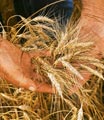 Some of the poorest and most disadvantaged wheat farmers live in areas with less than 350 mm annual rainfall and their livelihoods often depend solely on income from wheat production. Moreover, in these areas wheat is a staple food, providing around half the daily caloric requirement, and also constitutes an important source of fodder for livestock.
Some of the poorest and most disadvantaged wheat farmers live in areas with less than 350 mm annual rainfall and their livelihoods often depend solely on income from wheat production. Moreover, in these areas wheat is a staple food, providing around half the daily caloric requirement, and also constitutes an important source of fodder for livestock.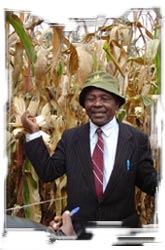 Farmers of the village of Kathaka Kaome in Embu district near Mount Kenya are saying that quality protein maize (QPM) is as nutritious as Githeri—a local dish made from maize and beans.
Farmers of the village of Kathaka Kaome in Embu district near Mount Kenya are saying that quality protein maize (QPM) is as nutritious as Githeri—a local dish made from maize and beans.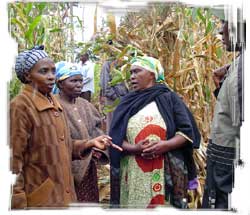
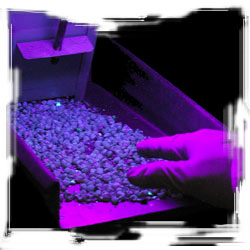 A CIMMYT research team is using an old but effective technique to get a head start on some very advanced crop science. Their aim is to breed high yielding maize that also resists infection by a dangerous fungus. As part of a USAID-funded project, the team uses ultraviolet or black light to identify maize that inhibits Aspergillus flavus, a fungus that produces potent toxins known as aflatoxins.
A CIMMYT research team is using an old but effective technique to get a head start on some very advanced crop science. Their aim is to breed high yielding maize that also resists infection by a dangerous fungus. As part of a USAID-funded project, the team uses ultraviolet or black light to identify maize that inhibits Aspergillus flavus, a fungus that produces potent toxins known as aflatoxins.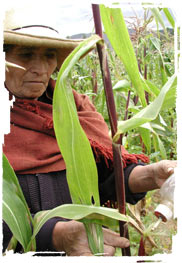 Farmers seal the corn earworm’s fate in Peru with an oily approach.
Farmers seal the corn earworm’s fate in Peru with an oily approach.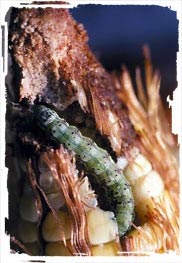
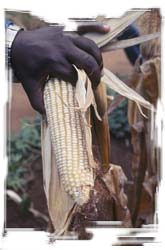 New, elite maize lines from CIMMYT offer enhanced nutrition and disease resistance.
New, elite maize lines from CIMMYT offer enhanced nutrition and disease resistance.
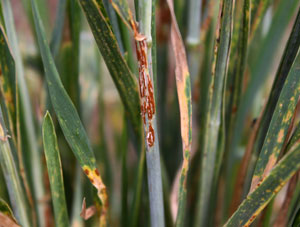 CIMMYT-led international efforts to identify and deploy sources of resistance to the virulent Ug99 strain of stem rust have received coverage on ABC1, the primary television channel of the Australian Broadcasting Corporation.
CIMMYT-led international efforts to identify and deploy sources of resistance to the virulent Ug99 strain of stem rust have received coverage on ABC1, the primary television channel of the Australian Broadcasting Corporation.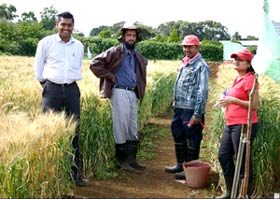 As the price of wheat goes up, countries such as the Republic of Mauritius are feeling the pinch. A former British colony off the coast of Madagascar, it imports most of its wheat from France and Australia. But with help from CIMMYT, the island has started trials to grow its own wheat—and results to date look promising.
As the price of wheat goes up, countries such as the Republic of Mauritius are feeling the pinch. A former British colony off the coast of Madagascar, it imports most of its wheat from France and Australia. But with help from CIMMYT, the island has started trials to grow its own wheat—and results to date look promising.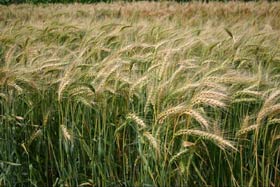
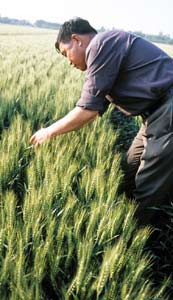 Three high-quality wheat varieties developed by researchers from the Shandong Academy of Agricultural Science and the Chinese Academy of Agricultural Science (CAAS), drawing on CIMMYT wheat lines and technical support, were sown on more than 8 million hectares during 2002-2006, according to a recent CAAS economic study. They contributed an additional 2.4 million tons of grain—worth USD 513 million, with quality premiums.
Three high-quality wheat varieties developed by researchers from the Shandong Academy of Agricultural Science and the Chinese Academy of Agricultural Science (CAAS), drawing on CIMMYT wheat lines and technical support, were sown on more than 8 million hectares during 2002-2006, according to a recent CAAS economic study. They contributed an additional 2.4 million tons of grain—worth USD 513 million, with quality premiums. Borlaug, still a consultant with CIMMYT, is also the President of the Sasakawa Africa Association, which is devoted to improving the lives of the rural poor in sub-Saharan Africa. One of his reasons for visiting Obregón this time was to see and learn about a technology developed by Oklahoma State University (OSU) and CIMMYT. The approach allows farmers easily and cheaply to determine the optimum application of fertilizer for a developing wheat or maize crop. Fertilizer resources are scarce in much of Africa, so timely application of the correct amounts can save farmers money and help produce a better crop.
Borlaug, still a consultant with CIMMYT, is also the President of the Sasakawa Africa Association, which is devoted to improving the lives of the rural poor in sub-Saharan Africa. One of his reasons for visiting Obregón this time was to see and learn about a technology developed by Oklahoma State University (OSU) and CIMMYT. The approach allows farmers easily and cheaply to determine the optimum application of fertilizer for a developing wheat or maize crop. Fertilizer resources are scarce in much of Africa, so timely application of the correct amounts can save farmers money and help produce a better crop.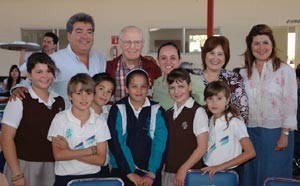
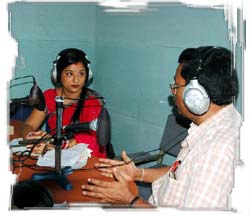 A radio program in Nepal brings information to farmers in a language they understand.
A radio program in Nepal brings information to farmers in a language they understand.
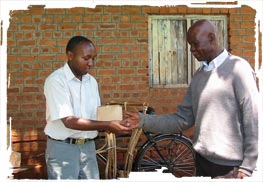 Experimental auctions in Kenya gauge farmer interest in vitamin A-enriched maize.
Experimental auctions in Kenya gauge farmer interest in vitamin A-enriched maize.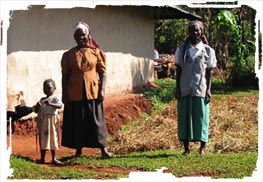 Determining how consumers will balance their desire for nutritionally superior maize while sacrificing the color to which they are accustomed sheds light on whether or not biofortified maize will be readily adopted. “Despite a need for this knowledge, very few consumer studies of the rural poor in sub-Saharan Africa have been done,” says Hugo De Groote, CIMMYT economist.
Determining how consumers will balance their desire for nutritionally superior maize while sacrificing the color to which they are accustomed sheds light on whether or not biofortified maize will be readily adopted. “Despite a need for this knowledge, very few consumer studies of the rural poor in sub-Saharan Africa have been done,” says Hugo De Groote, CIMMYT economist.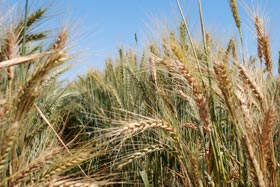 In 2009, out of a global population of 6.8 billion people, more than 1 billion regularly woke up and went to bed hungry. By 2050 the population is expected to grow to 9.1 billion people, most of whom will be in developing countries. Unless we can increase global food production by 70%, the number of chronically hungry will continue to swell. To help ensure global food security, a new research consortium aims to boost yields of wheat—a major staple food crop.
In 2009, out of a global population of 6.8 billion people, more than 1 billion regularly woke up and went to bed hungry. By 2050 the population is expected to grow to 9.1 billion people, most of whom will be in developing countries. Unless we can increase global food production by 70%, the number of chronically hungry will continue to swell. To help ensure global food security, a new research consortium aims to boost yields of wheat—a major staple food crop.